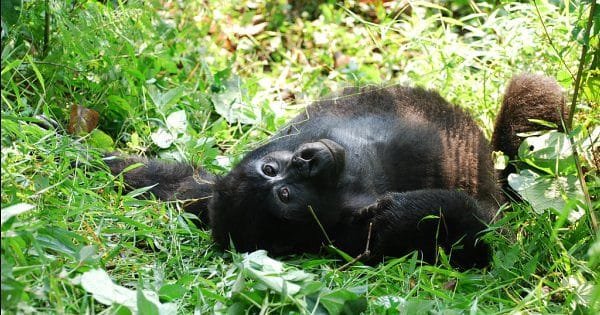
INTERNATIONAL
info@allinafricasafaris.com
INTERNATIONAL, 24/7 Help Support
USA/CANADA | M-F 9:00 am - 5:00 pm

Where Are Mountain Gorillas Found in The World? Only three countries—Uganda, Rwanda, and the Democratic Republic of the Congo—are home to mountain gorillas, which are widely recognized as one of the greatest creatures in the world.
Bwindi Impenetrable National Park and Mgahinga Gorilla National Park are the two national parks in Uganda where mountain gorillas can be found. The Virunga National Park in the Congo is home to mountain gorillas, while Rwanda’s magnificent Volcanoes National Park is a destination.
In addition to mountain gorillas, the Congo is home to “Eastern and Western” lowland gorillas, which are also found in Cameroon and other west and central African nations. However, the number of eastern lowland gorillas has dropped to less than 8,000, whereas the total population of western lowland gorillas is approximately 250,000.
Because mountain gorillas cannot survive in captivity like lowland gorillas, they receive excessive care. There are currently roughly 1065 mountain gorillas left in the world. The IUCN Red List designated mountain gorillas as endangered in 2018.
Threats like habitat degradation, sickness, poaching, and the production of charcoal have occasionally caused their numbers to drop, but the government and several groups have stepped up to restore the gorilla protection areas with consistent monitoring.
Keep in mind that mountain gorillas cannot live in a zoo.
Information on the World’s Mountain Gorillas
Male mountain gorillas are between 161 and 171 centimeters tall.
Female mountain gorillas can weigh between 70 and 98 kilos, while males typically weigh between 120 and 191 kilograms.
The reason adult males are called silverbacks is because, as they age, a saddle of gray or silver hair grows on their backs. But as individuals age, their hair gets shorter than it is on the majority of other body parts.
Gorilla trekking in Bwindi impenetrable national park
They inhabit two remote communities: one in the Bwindi Impenetrable National Park in Uganda, which connects to Sarambwe Nature Reserve, and another in the Virunga Volcanoes, which span three national parks in Rwanda, Uganda, and the Democratic Republic of the Congo (DRC).
High-altitude montane and bamboo forests, encircled by picturesque communities, are home to mountain gorillas. Where in the world can one find mountain gorillas?
As herbivores, mountain gorillas consume the leaves, stems, and shoots of 142 different plant species. They also consume small invertebrates, bark, roots, flowers, and fruits.
Approximately 98% of our DNA is shared with mountain gorillas.
They are regarded as the strongest primates still alive in the wild.
85% of their diet consists of leaves, shoots, and stems, but they can also consume ants, snails, larvae, roots, bark, and decaying wood. They can eat all day long.
Mountain gorillas enjoy sleeping in their nests, which they construct on the ground or atop tree branches in the evening.
They have sixteen distinct call kinds, which include vocalizations like roaring or hooting, beating their chests, and short barks when slightly startled.
Family groupings of at least thirty mountain gorillas, consisting of numerous females and a dominant male, are the norm. Nonetheless, the group’s males and females care for their babies by playing, caressing, and carrying them.
They have a lifespan of more than 40 years. Blackbacks are males that mature between the ages of 8 and 12. They can begin to grow silver hair on their hips and back around the age of twelve, which is why they are called silverbacks.
They may be threatened by human encroachment and poaching.
In Uganda, mountain gorillas can be seen in two different locations: Mgahinga Gorilla Forest National Park and Bwindi Impenetrable Forest National Park. Both are in the country’s southwest and can be reached by car from Kampala in about eight to nine hours.
A sizable population of the last mountain gorillas in the world can be found at Bwindi Impenetrable National Park. Of the approximately 1065 mountain gorillas in the park, about 650 are present. Where in the world can one find mountain gorillas?
It should be noted that in order to trek-track gorillas, you must purchase a gorilla permit, which grants you access to their natural habitat. With the assistance of the tour guide, a gorilla permit in Uganda can be purchased directly from the Uganda Wildlife Authority (UWA).
Gorilla trekking permits in Uganda cost USD 800 per person per day for non-natives, USD 700 for foreigners, and USD 300,000 for East African citizens.
A full-day experience that can only be done in Uganda’s Bwindi Impenetrable National Park is the Gorilla Habituation Experience. The cost of gorilla habituation is USD 1,500 each trek.
Primates can be found in Rwanda’s Volcanoes National Park, also known as “Parc National des Volcans.” Situated in the country’s northwest, Volcanoes National Park shares borders with Mgahinga Gorilla National Park and Virunga National Park in the Democratic Republic of the Congo. Where in the world can one find mountain gorillas?
The existence of mountain gorillas in Volcanoes National Park is a testament to Dian Fossey’s outstanding efforts in initiating gorilla study, which has contributed to the preservation of primates in the region.
The Rwanda Development Board, or “RDB,” is the government agency in charge of granting gorilla permits so that visitors can observe the primates in Rwanda’s Volcanoes National Park. The cost of a Rwanda Gorilla Trekking Permit is $1500 USD per expedition.
Gorillas can be found in the Democratic Republic of the Congo’s Virunga National Park, which shares borders with Uganda’s Mgahinga Gorilla National Park and Rwanda’s Volcanoes National Park.
Despite the fact that internal wars have plagued the Democratic Republic of the Congo (DRC) for many years, aid organizations have emerged to collaborate with them in order to facilitate the study and conservation of mountain gorilla habitat.






